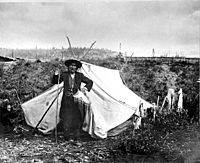Hän facts for kids

Chief Isaac of the Han, Yukon Territory, ca. 1898
|
|
| Total population | |
|---|---|
| 310 | |
| Regions with significant populations | |
| Canada (Yukon) | 250 |
| United States (Alaska) | 60 |
| Languages | |
| English, Hän | |
| Religion | |
| Christianity | |
| Related ethnic groups | |
| Gwich'in and other Alaskan Athabaskans | |
The Hän people, also known as Han or Hwëch'in, are an Indigenous group in Canada and Alaska Native people in the United States. Their name means "People of the River," referring to the Yukon River. They are part of the larger Athabaskan-speaking family.
Historically, the Hän lived in a heavily forested area. This land was around the Upper Yukon, Klondike, Bonanza Creek, and Sixtymile Rivers. Their traditional territory crossed what is now the border between Alaska and the Yukon Territory in Canada. Later, many Hän people settled in Dawson City, Yukon and Eagle, Alaska.
Contents
Understanding the Hän Name
The name Hän or Han is a shorter version of their own name, Hwëch'in. It also comes from the Gwich'in word Hangʷičʼin. Both names mean "People of the River," specifically the Yukon River.
Over time, this name has been spelled in many ways. Some examples include Hankutchin, Han-Kootchin, and Hän Hwëch'in. Sometimes, the Hän were mistaken for a different group called the Gwichʼin.
European traders also had names for the Hän people. French traders called them Gens du fou, meaning "People of the Mad." They were also known as Gens de Bois, or "People of the Woods." This name came from their home in the forests.
History of the Hän People
The Hän were one of the last Athabascan groups in the North to meet Europeans. In 1851, Robert Campbell was the first known white person to enter their land. He was from the Hudson's Bay Company.
Later, in 1873 and 1874, two trading posts were set up. This happened after the United States bought Alaska. These posts allowed the Hän to trade with white settlers.
Changes in Lifestyle
Trading with Europeans changed the Hän way of life. They slowly moved from hunting and fishing to trapping furs. They started to rely on European goods like guns, clothing, and canvas. This shift happened between 1887 and 1895.
A church mission was also started in Hän territory. Over time, many Hän people began to combine their traditional beliefs with Christianity. Sadly, the Hän also faced many new diseases from Europeans. They had no protection against these illnesses, which caused many deaths.
Hän Culture and Traditions
Traditional Food Sources
Historically, fish was the main part of the Hän diet. King salmon were caught in June along the Yukon River. Chum salmon were caught in August.
The Hän used many tools for fishing. These included weirs, traps, gill nets, and spears. Salmon was dried and stored. This way, they had food for the long winter.
Between the salmon runs, from June to September, river camps were empty. Hän men hunted other animals like moose, caribou, birds, and bears. Women would fish for other types of fish. They traditionally cooked using hot stones in woven baskets.
Hän Homes
The main type of Hän home was a square house. It was partly dug into the ground. These homes were made of wooden poles and insulated with moss. They were called moss houses.
When traveling, the Hän built temporary homes. These were domed houses made of animal skins. The skins were stretched over branches tied together.
The Hän Language
The Hän language is very similar to Gwich'in. It is also related to Upper Tanana and Northern Tutchone. The language became important during the Gold Rush in the late 1800s. It was used by different groups to communicate.
Today, the Hän language is very rare. Only a few people still speak it, and they are all over 60 years old. This makes it one of the most endangered languages in Alaska. Scientists believe the language might have very old roots in the region.
See also


